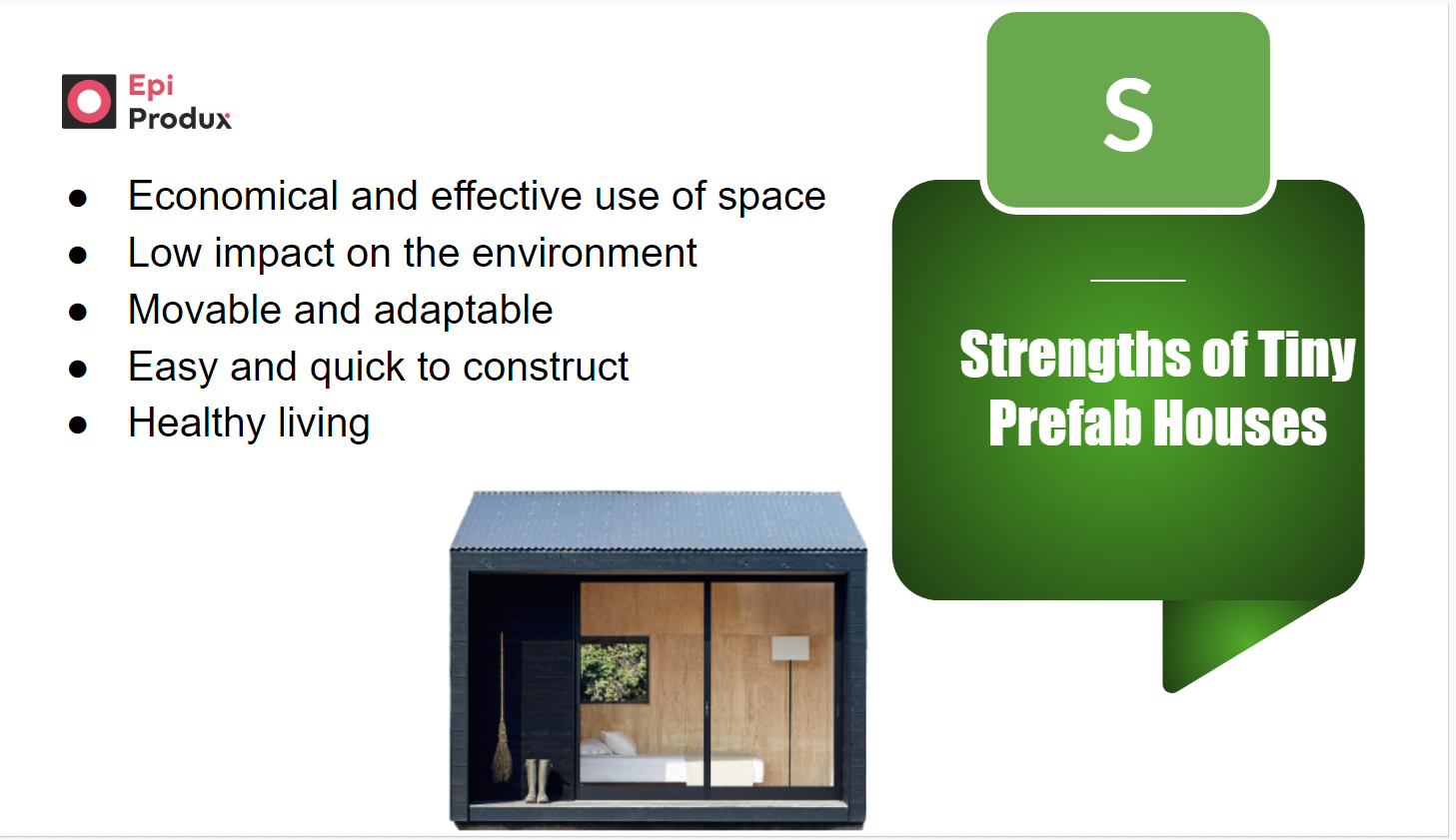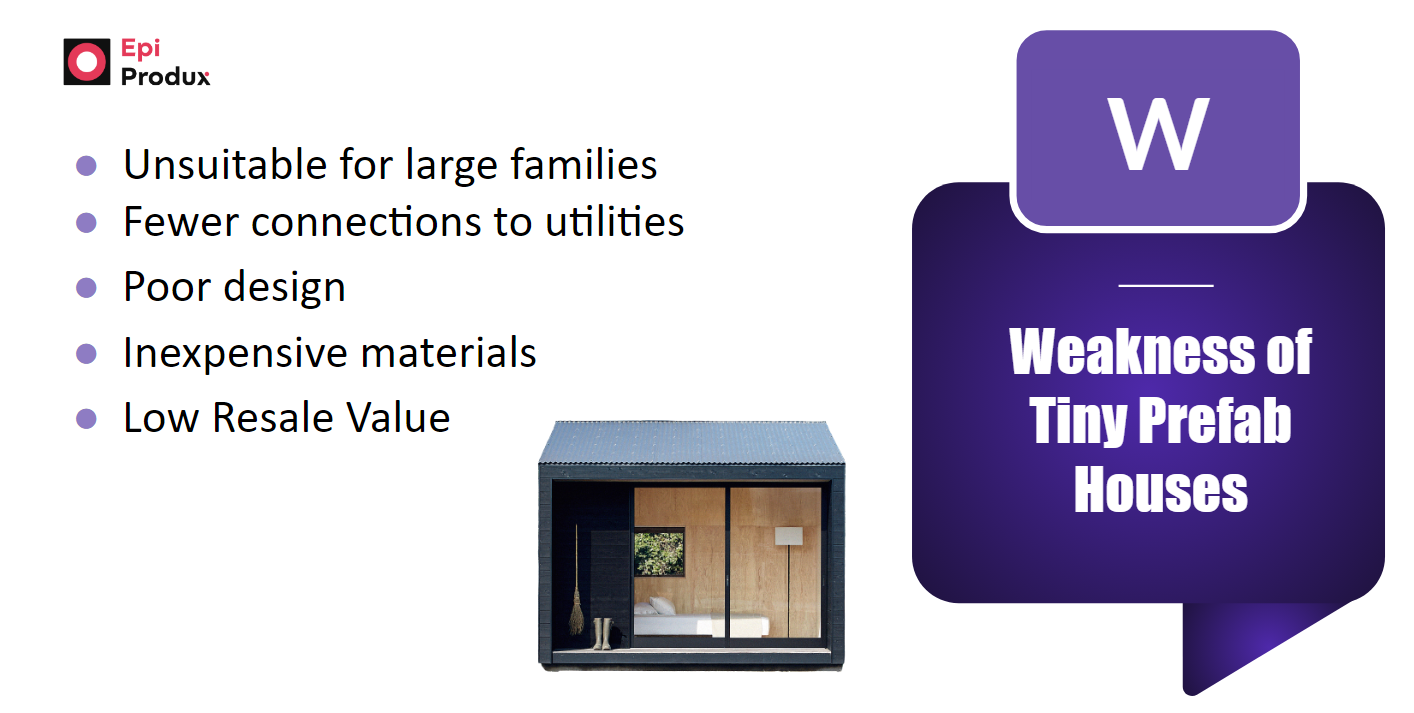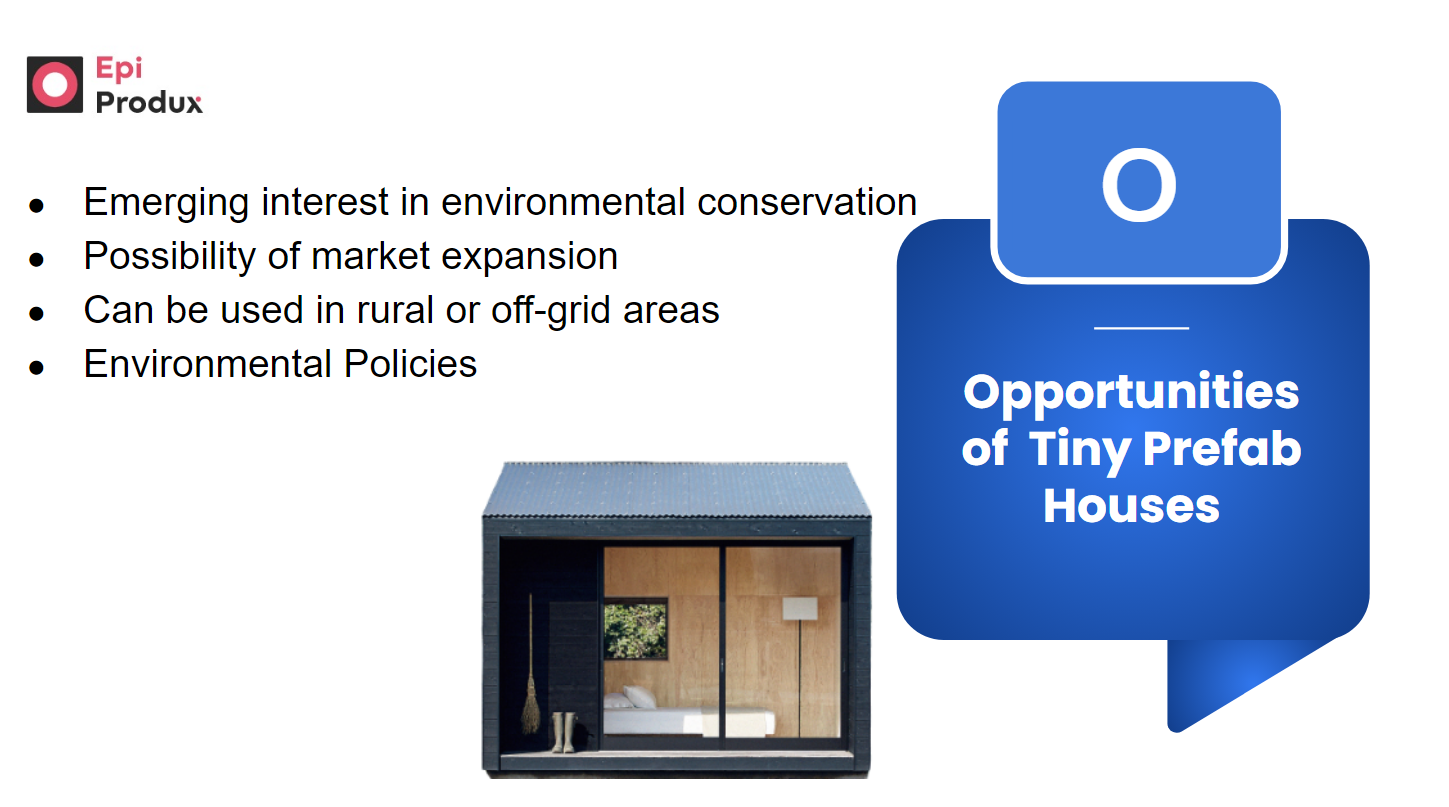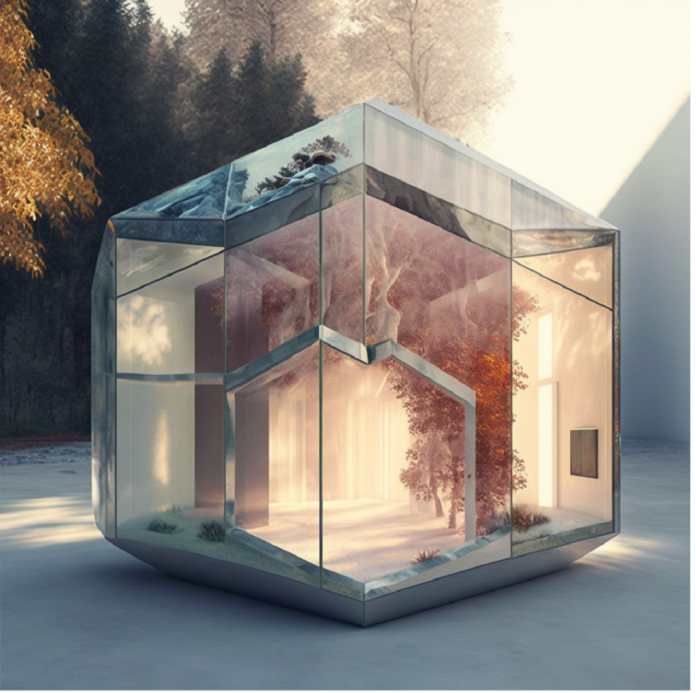UNDERSTANDING SWOT ANALYSIS
A SWOT analysis is a strategic planning tool, that evaluates a company, product, or project’s strengths, weaknesses, opportunities, and threats. It is a method that companies use to determine the internal and external factors that may have an impact on their success. Strengths, weaknesses, opportunities, and threats are referred to by the abbreviations SWOT.
Managers can follow the SWOT analysis to identify and prioritize the most significant factors impacting organizational objectives. The SWOT analysis is the beginning of strategic planning and decision-making. This analysis can help learn the potential threats and opportunities that the company can tap into and the positive and negative aspects of a project or product.
Overview of tiny prefab houses and their potential use for mindfulness

The idea of tiny prefab houses has gained much popularity in California and other parts of the world. Sparked by the desire for sustainable homes and the rising concern for mental health in a family setting, a section of builders have gone to a new level to create tiny houses that fit the occupants’ health and mindfulness. Whether you are looking to construct a new home or move to a new rental section, there is always something you can learn from the emergence of tiny prefab houses.
The design of tiny prefab houses keeps changing over time depending on customer needs. These houses serve different needs: prevention of overcrowding, mental health promotion, and prevention of environmental pollution, among others. Tiny homes provide cheap dwelling options for many people looking for affordable housing.
Tiny prefab homes also called “tiny homes” or “micro homes,” are small, modular houses constructed off-site and delivered to their final locations. These houses are typically smaller than 500 square feet and are built with a focus on sustainability and high efficiency. Tiny prefab houses are gaining popularity as an alternative to traditional, big homes among people looking for affordable housing.
Tiny prefab homes can have significant financial and health advantages for people who want to simplify their lives and exercise a different life focused on mindfulness and mental health. These homes’ small size and simple design may inspire residents to live more comfortably and exercise much freedom. People can concentrate on what is truly important in their lives thanks to the simplicity of tiny homes, allowing people to exercise freedom and flexibility. Additionally, the compact design of these homes may promote a more environmentally friendly and sustainable way of life, and boost the overall health of the occupants.
Tiny prefab homes are flexible; they can be used as permanent residences, a section may be used as a second home, while another section can be used as a rental property or even as lodging. They are adaptable, simple to construct, and can be installed in different places, including remote locations. Additionally, they can be customized to fit the homeowner’s unique requirements and preferences. This makes it an excellent choice for middle-class Californian families with strong health awareness who reside in single-family homes.
Market analysis
There is a booming market for tiny prefab houses in California. The target market for these houses is middle-class families living in small family setups with a high-income level. Such families will look for more private areas than the traditional large home. California is known for its very high-income activities; hence, it can be a perfect platform for tiny prefab houses. Also, residents here are very concerned with their health and love to incorporate activities supporting sustainable living.
The continued rise of demand for affordable housing options will affect real estate activities in California. The unique and cost-effective design of these houses makes them preferred by many people trying to reduce the cost of living. These houses require less land and have fewer maintenance activities. The tiny houses focus on reducing the size of living quarters since they don’t require a lot of space.
SWOT ANALYSIS’ Strengths
Several advantages come with tiny prefab houses. These include the following:
Affordability
One of the main advantages of prefab tiny homes is affordability. These homes enable a more affordable way of living because they are typically less expensive than buying larger homes. Additionally, because of their compact size, these homes make better use of their available space, which can be helpful for middle-class families in California who might be struggling with high housing costs. People who exercise financial strains may opt for a prefab tiny section to cut the high cost of living.
Low environmental pollution
Another advantage of these homes is the prevention of environmental impact since their construction does not involve extractive activities. These homes are built with a focus on sustainability and high energy efficiency, which can be a crucial factor for families focusing on the prevention of environmental pollution.
Portability and adaptability
The Portability that comes with a prefabbed section is a significant benefit for middle-class families living in California who might be looking for an alternative to larger homes. Tiny prefab houses are very portable and adaptable. They can be positioned in various places and customized to the homeowner’s unique requirements and preferences.
Simplicity
Constructing tiny prefab homes is quick and straightforward, which can be especially helpful for families looking for an alternative to traditional homes. Simple building activities can help families spend less time working on construction while lowering costs.
SWOT ANALYSIS’ Threats
Market resistance
One threat to the prefab home business is low acceptance by potential clients. This is mainly a result of a misunderstanding. Despite the people’s need for cheaper and more affordable houses in California, there still needs to be more clarity on the numerous benefits that come with this exercise. People need to be fully aware of the various benefits surrounding this exercise. As a result, small families may need help to make the right decision as to whether to purchase tiny prefab houses.
Zoning and building code restrictions
Learn the government policies in your state before erecting a prefab section. Different states have different laws that focus on the prevention of low-quality housing. Therefore, Some state laws may make this exercise very challenging. Some rules may lead to high costs in constructing and maintaining tiny prefab houses and make it hard for clients to find suitable locations.
Poor infrastructure
Poor infrastructure in some locations may be another prevention of tiny fab sections. Lack of amenities like hospital, electricity, water, and security may be a significant inhibitor to this exercise. Some locations may be very cheap for business but will not be viable if they are not accessible to the clients.
Low resale value
A prefab home section is very affordable, even for people earning a low income. But similarly, the resale value is not different; it is equally very low. If a family wants to dispose of their prefab home, the price will be meager compared to traditional homes.
SWOT analysis’s opportunities
A new trend of minimalistic living
Minimalistic living activities have gained much popularity due to their relation to mental health. As such, the demand for tiny living houses continues to increase. This exercise promotes mental health and is, therefore, more sustainable. This is favorable to the market since people are looking for a more sustainable way of living. Many people are looking for ways to apply mindfulness techniques to their daily lives. People who live in tiny prefab homes may have a unique opportunity to live a more modern lifestyle that boosts their health.
The potential for expansion in the wellness/mindfulness market represents another business opportunity for tiny prefab homes. The demand for tiny prefab homes created with wellness and mindfulness in mind is likely to rise.
Technological growth has opened a chance for people to learn more ways of making money, and prefab houses haven’t been left behind. Tiny prefab homes can also be used as rental properties, guest houses, or vacation homes, giving families extra income.
You can make prefab houses better by adding new technologies. Adding accessories like air fresheners, electric fans, Wi-Fi, and lighting, among others, can make prefab homes very attractive to potential clients. The occupants need to feel comfortable, like in traditional home sections. These activities can promote health and lower stress levels.
Creating more spaces on the off-grid sections. Many people tend to avoid living in off-grid areas. However, prefab houses can promote livelihoods in such areas. This exercise may involve the installation of electricity in such sites, constructing of roads, and installing water, among other activities. However, prefab houses can make life more practical even without these activities.
Weaknesses.
One of the main weaknesses of tiny prefab houses for mental awareness is their limited space. These houses are typically less than 500 square feet, making them less practical for families with children or those who need more room for storage or other uses. The limited space can also make it difficult for people to entertain guests or host overnight visitors. People living in these areas may need more space to follow the best health practices.
Another area for improvement is the limited design options. Prefab tiny houses are constructed using minimalistic designs and follow only some traditional building steps. This makes them less appealing to some people. Many home buyers exercise a lot of caution when looking for houses for sale, ensuring that every feature is available. But for tiny prefab houses, their minimalistic design leaves out many features making the building lose some touch.
Limited utility connections can also be a weakness of tiny prefab houses. These houses may need access to essential services such as electricity, water, and sewage, making them less practical for some families. Most of the technological activities in today’s life require the presence of these amenities. The lack of these amenities is an excellent prevention of growth.
Finally, the limited privacy in tiny prefab houses can be a weakness. These houses are typically tiny and open, making it difficult for people to have separate living spaces or maintain their privacy. This can be incredibly challenging for families with children or those working from home. People may need help maintaining their privacy or have separate living spaces in these homes because they are frequently small and open.
Summary of the main findings of the SWOT analysis.
When assessing this kind of housing, it is crucial to consider several significant strengths, weaknesses, opportunities, and threats highlighted by the SWOT analysis of tiny prefab houses for mindfulness.
Strengths consist of:

- economical and effective use of space
- low impact on the environment
- movable and adaptable
- easy and quick to construct
- Possibility of mindfulness practices enhancing health and well-being
weaknesses:

- confined area with limited access
- little variety in design
- fewer connections to utilities
- Limited customization capabilities
- Potential for zoning and building code restrictions in California due to a lack of privacy
Opportunities consist of:

- The growing interest in environmental conservation activities and straightforward living
- Possibility of market expansion for wellness and mindfulness, Possibility of use as second homes, rental properties, or lodging facilities
- Possibility of use in rural or off-grid areas
- The progressive laws of California regarding environmental practices and different types of housing
Threats consist of:

- Limited consumer understanding and acceptance
- Building code and zoning restrictions
- Some areas lack infrastructure and services.
- Low potential for resale
- The cost of living is high in California.
To sum it up, tiny prefab homes for mindfulness present an intriguing choice for middle-class Californian families with high health awareness who live in single-family homes. Those seeking to simplify their lives and concentrate on more productive activities may find them affordable and sustainable options. Before making a choice, it’s crucial to consider the restrictions and potential difficulties of this kind of housing.
Final thoughts
In conclusion, tiny prefab homes for mindfulness present an intriguing choice for middle-class families in California who reside in single-family homes and have a keen awareness of their health. While the Portability and simplicity of tiny houses can provide a feeling of freedom and flexibility, their small size and minimalist design can encourage a more healthy and mindful way of living. Additionally, the compact design of these homes may promote a more environmentally friendly and sustainable way of life.
The growing demand for sustainable and minimalist living and the potential for growth in the wellness/mindfulness market creates opportunities for tiny prefab houses in California. The state’s progressive policies on sustainable living and alternative housing options also support the use of tiny prefab houses.
But it’s also worth noting that this exercise is full of challenges. There are many challenges, such as low market acceptance and understanding, zoning and building code restrictions, a lack of infrastructure and services in some areas, low resale value, and the high California cost.
In general, tiny prefab homes for mindfulness and health are intriguing and great alternatives for middle-class families in California who are concerned about their health and are looking for a smaller home. Before making a choice, it’s crucial to carefully consider the restrictions and potential difficulties of this kind of housing.
Additional research and thought.
There are various considerations before investing in tiny prefab houses in California for mindfulness and health awareness. Let’s look at the multiple reviews that may be made.
Learn and follow your area policies before investing in prefab houses. Understanding all the local zoning codes is vital before building prefab houses. Failing to follow the rules may pose significant future problems, result in court cases and fines, or render the whole investment useless.
Consider all the potential costs involved in the activities. The potential costs of creating and maintaining the prefab houses must be justifiable. The cost of living in California is very high, and most residents are looking for affordable homes. Consider charges in the land, construction, and other utilities since this will determine the overall cost of the whole exercise.
Research different tiny prefab house companies and builders: A large section of builders specialize in tiny prefab houses; therefore, it’s essential to research other options to find the right one that fits your needs, preferences, and budget. Professional builders follow all the legal requirements throughout their construction activities to ensure the house is safe for the occupants.
Consider the resale value. You may need to sell your prefab section in the future. What will be the resale value? Although the assets depreciate with time, investing much money in a prefab house may not be worth it. It’s essential to consider the potential resale value of a tiny prefab house before deciding because small prefab homes may have a different value than traditional, larger homes. But you also need to ensure that you follow all the construction regulations.
Research the impact of mindfulness practices in a tiny home: Studies demonstrate the beneficial effects of mindfulness techniques on both physical and mental health. You can learn how tiny houses can enhance your general well-being by learning about the impact of mindfulness techniques in one. Follow all the laid practices throughout the construction exercise.
Speak with experts and Tiny homeowners: It’s essential to speak with experts and tiny homeowners to understand better the pros and cons of living in a tiny prefab home and how it can impact your daily life. People who have previously carried out the exercise will most likely tell you where they went wrong and advise you on the most crucial activities to undertake through the construction process.
Finally, it’s essential to Consider your lifestyle and needs: Lastly, it’s important to consider your lifestyle and needs before making a decision. Think about how a tiny prefab house will fit into your current lifestyle and whether it will meet your needs in terms of space and functionality. This will make it easy to address the needs of other potential occupants when carrying out the construction exercise.
Frequently asked questions
What is a tiny prefab house?
A tiny prefab house is a small house section, a modular home built off-site and then transported to its final location. These houses are typically less than 500 square feet in size and are designed to be highly efficient and sustainable.
What are the potential benefits of a tiny prefab house for mindfulness?
These houses’ small size and minimalist design can encourage a more intentional and mindful way of living. The simplicity and Portability of tiny homes can also offer a sense of freedom and flexibility, allowing people to focus on what is truly important in their lives. Tiny prefab houses boost mental health and increase personal comfort. Additionally, the small size of these homes can encourage a more sustainable and environmentally conscious lifestyle.
Are tiny prefab houses legal in California?
It depends on the specific location and zoning laws. It’s essential to learn and follow the local zoning and building codes to determine if tiny prefab houses are permitted in your area and if they meet the requirements of local building codes. The home builders must also be sure that the construction activities follow all the local regulations to avoid legal problems.
How much does a tiny prefab house cost?
The cost of a tiny prefab house can vary depending on location, size, and customization factors. However, they are typically less expensive than traditional, larger homes. But it would help if you learned the most necessary amenities you need before buying a prefab section. For example, if the customer has young children who go to school, it’s vital to ensure that the place is accessible to school buses or just next to a school.
Can tiny prefab houses be customized?
Yes, tiny prefab houses can be customized to meet the specific needs and preferences of the homeowner. Even though tiny prefab houses are made with a lot of simplicity, you can add crucial features to make them more appealing. For example, you may add extra features for prevention against wear and tear or add fire prevention systems to keep the facility safe. Also, you may add things like indoor plants that boost health and promotes a good living style for the occupants. But you must follow the local zoning codes to ensure you stay within the set legal limits.
Are tiny prefab houses suitable for families with children?
Tiny prefab houses are typically less than 500 square feet in size, making them less practical for families with children or those who need more room for storage or other uses. It’s essential to consider your lifestyle and that of your family members.
Why is it better to do a SWOT analysis for a product instead of a company?
Because it helps to identify the strengths, weaknesses, opportunities, and threats that could impact the product’s success, a SWOT analysis is helpful for products and businesses. By doing a SWOT analysis, the company that makes or sells the product can learn more about its position in the market and find ways to improve it.
Importance of SWOT ANALYSIS for product’s manufacturer or marketer
Recognize the product’s position in the market’s competitive landscape: The manufacturer or marketer can better learn how the product compares to its rivals and create strategies to strengthen its competitive position by identifying the strengths and weaknesses of the product.
Identify areas for improvement: The manufacturer or marketer can create strategies to enhance the product’s performance and address any problems that may be affecting its success by identifying the product’s weaknesses.
Take advantage of new opportunities: By identifying the opportunities in the market, the manufacturer or the marketer can develop new strategies to capitalize on these opportunities and expand the product’s reach.
Mitigate potential threats: By identifying the threats in the market, the manufacturer or the marketer can develop strategies to mitigate these threats and reduce the risks of the product’s failure.
How the Epiprodux SWOT tool creates a good solution for managers
There is a great advantage that comes with the Epiprodux product management tool. Managers may use the SWOT analysis to overview the product state quickly. The tool also helps you precisely learn the product and its features and make it better to meet consumer demands.
The product management tool within the EpiProdux software allows managers to track and manage all aspects of the product, including sales, marketing, and development. This information can be used to create a detailed SWOT analysis of the product, which can help managers learn the product’s strengths, weaknesses, opportunities, and threats.
Having a product SWOT analysis tool within the product management software allows managers to consolidate all the necessary information, which makes it easy for them to quickly and easily assess the product’s current state. This can help managers to make more informed decisions about the product, such as identifying areas for improvement or capitalizing on new opportunities.
Additionally, having a product SWOT analysis tool within the product management software can also help managers track the product’s progress over time, which can help identify trends and make decisions about future product development.
In summary, EpiProdux software, with its integrated product management tool and a product SWOT analysis feature, is a good solution for managers because it provides them with a comprehensive and detailed analysis of the product, which allows them to make more informed decisions and track the progress of the development over time.
Using the Opportunities in SWOT to provide ideas about future products
Opportunities in a SWOT analysis can provide great ideas for future product features because they identify areas where the product can be improved or expanded to meet new customer needs. By identifying these opportunities, managers can develop new product features that will help to improve the product’s performance and increase its appeal to customers. Also, this can help in the prevention of losses emanating from investing in the wrong business activities.
Here are a few examples of how opportunities in a SWOT analysis can be used to develop new product features:
Identifying new market segments: SWOT analysis helps product managers identify new market segments that the product can target. Managers can develop new product features that will appeal to these segments and increase the product’s appeal to new customers.
Adding new functionality: If the SWOT analysis identifies areas where the product’s functionality can be improved, managers can develop new product features that will add new functionality to the product and make it more appealing to customers.
Improving the product’s performance: If the SWOT analysis identifies areas where the product’s performance can be enhanced, managers can develop new features that will improve the product’s performance and make it more appealing to customers.
Addressing customer complaints: If the SWOT analysis identifies customer complaints about the product, managers can develop new product features that address these complaints and improve the product’s appeal to customers.
Addressing new regulations: If the SWOT analysis identifies new rules that the product must comply with, managers can develop new features that will help the product comply with these regulations and increase its appeal to customers.
Overall, by identifying opportunities in a SWOT analysis, managers can develop new product features that will help to improve the product’s performance, increase its appeal to customers, and address unique market needs.


